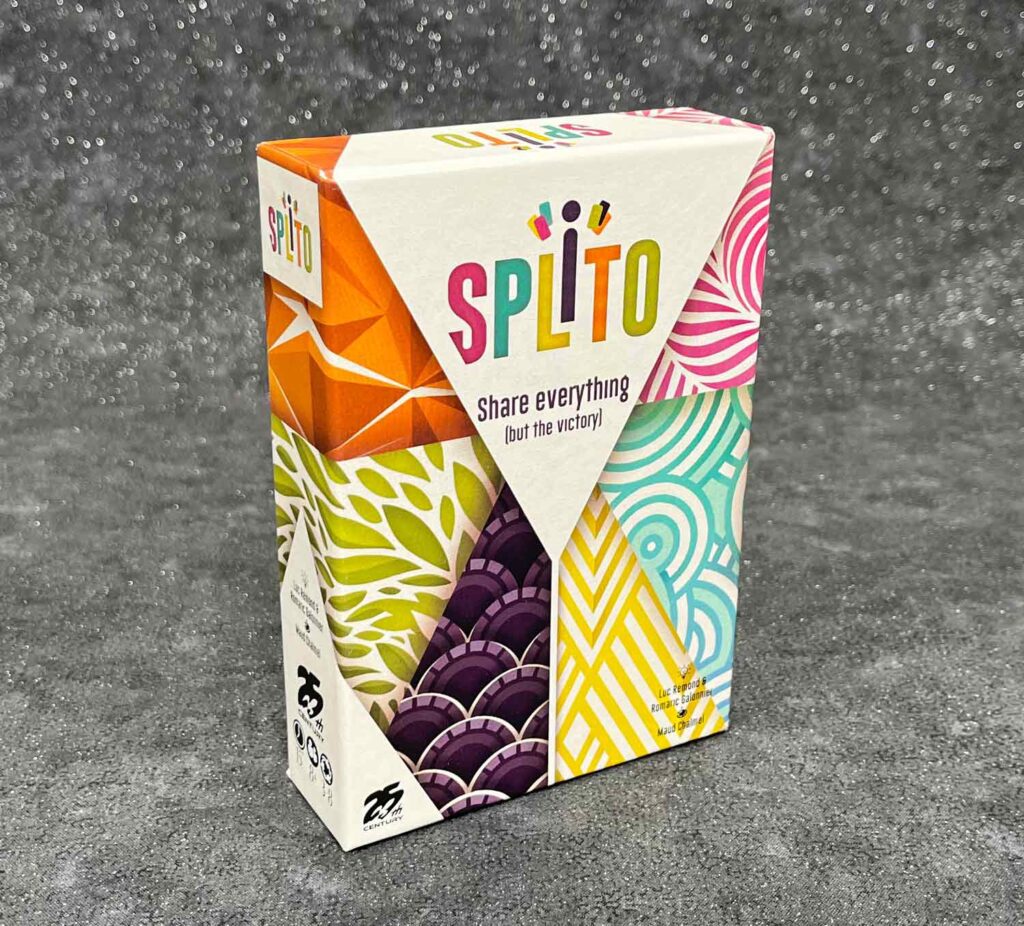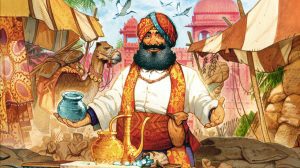Disclosure: Meeple Mountain received a free copy of this product in exchange for an honest, unbiased review. This review is not intended to be an endorsement.
Back in 2015 Stonemaier Games released a game called Between Two Cities, designed by Matthew O’Malley and Ben Rosset. Along with being an interesting tile-laying, city-building game, it introduced a really unique mechanism (at least one that I’d never seen at that time). Instead of working on their own city, each player cooperatively built TWO cities, the one on their left and the one on their right. This mean that each player was responsible for working together with two other players to make each city as successful as possible, while understanding that the better each city did, the more their competitors would score.
Fast forward 7 years to when we released our Most Anticipated Games of Essen 2022, and I noticed Splito, which would go on to be released by 25th Century Games. Splito leverages this same cooperative gameplay, but uses cards, and plays up to 8, simultaneously. If you know anything about me, you know how much I love my card games. So I had to get a copy and bring this delightful, thinky game to you, our dear readers.
Let me tell you about Splito.

How to Play Splito
In Splito, you attempt to earn the most points by playing cards into specific regions (the region on your left and the region to your right). This seems to be one of the hardest things for most players to understand, so here’s an illustration from the Splito rulebook.

A Quick Detour About Cards
Before I get too far into gameplay, let’s quickly talk about the cards, otherwise, some of this won’t make sense. There are two types of cards in the deck: number cards and objective cards.
- There are 72 total number cards—2 complete sets of 6 different colored cards, numbered 1 through 6.
- There are 37 objective cards, with a mix of simple objectives like “no 3s” or “at least one blue, orange, and yellow card”, combined with more challenging objectives like “a strict majority of black cards” or “exactly 1 card of each value”.
- Objective cards are worth between 1 and 4 diamonds, shown at the top right and left of each card.
- At the beginning of the game, two public objective cards are placed in the center of the table. Not only do these provide a helpful direction for the first few rounds, but these objective cards can be one by one region during scoring, adding to the score of those two players.

Splito Gameplay
Each player starts with a hand of 13 cards, regardless of player count. At the beginning of a round, each player simultaneously selects one card, and places it face down in one of their regions. Which card you choose, and where you put it, is at the core of the game, and we’ll be talking more about that in a moment. After everyone has chosen their card, the cards are turned over. Then each player passes the remainder of their cards to the player on their left and the process begins again. The game continues in this way until all cards have been played.
Splito Scoring
At the end of the game players determine which region has won the public objective (if any), then include those scoring cards in that region’s tally. Then each region determines which objectives they’ve scored and adds up the points. Finally each player multiples the scores of their regions to determine their final score. The player with the most points wins the game.

Final Thoughts
Splito is a competitive cooperative game in that you’re working together with the players to either side of you, but you’re also competing against each of them at the same time. It wouldn’t do to continue earning points for the region between you and Jasmine, because she’ll be earning those points as well. And you can’t neglect the region between you and Ari because you want as high a score as possible in each region because…multiplication. And even worse is that sometimes you don’t have a good choice…you’ve got to pick a card, even if that card screws up one of the objective cards.
But is that such a bad thing? Cards and objectives are public which means that attentive players can keep a mental tally of the scores for each region. And if Jasmine is doing really well on the opposite side, then maybe it’s not so bad if you do a little whoopsie and ruin an objective card between the two of you. [insert Steve Erkel voice “Did I do that?”].
Splito has been a delight to play, and a challenge at the same time. It’s quick, because of the simultaneous play, games are over in 20+ minutes. The graphic design and artwork are really attractive, and the cards are a little narrower than average, with a smooth finish. That means they’re nice to hold and to look at. But the game can force you to make tough decisions, because you’re constantly having to scan the table to see where you stand against some of the more valuable objectives, while also balancing where to play the card from your hand to maximum effect.
Earlier I mentioned that Splito uses the same gameplay style as Between Two Cities; but I think it’s more effective here because it fixes what I’d consider to be a flaw in the original game: scoring. In Between Two Cities your final score was whichever of your two cities scored the lowest. In multiple games of BTC I encountered pairs of ties, especially in 4 player games. That turned me off the game because ties shouldn’t happen that often, and it was unsatisfying.

But because of the way that Splito multiplies scores it’s a little less likely that will happen. And even though I did get a single tie in one of my games, the remainder of my plays were tie-free, and everyone enjoyed themselves.
And I suppose that “everyone enjoyed themselves” is a great way to end this review. Check out Splito and maybe some of that enjoyment might be yours as well.












Add Comment